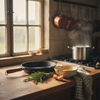Cooking Eggs On Stainless Steel: Complete Guide
Key Takeaways
- Cooking eggs on stainless steel can be challenging but rewarding.
- Many home chefs struggle with eggs sticking to stainless steel pans.
- Mastering stainless steel cooking techniques yields superior flavor.
- Stainless steel offers professional-quality results that non-stick pans cannot match.
Table of Contents
- Crack Into Culinary Confidence, Why Stainless Steel for Eggs?
- The Science Behind Sticking (and How to Master It)
- Choosing the Right Stainless Steel Pan for Eggs
- Fat Matters, Which Oils Make Eggs Glide
- Room Temperature Eggs, The Quiet Power Move
- Cooking Techniques Demystified: Step-by-Step for Every Egg Style
- Troubleshooting: Solving the 5 Most Common Stainless Steel Egg Problems
- Stainless Steel vs. the Rest: Material Comparison for Egg Cooking
- Health & Safety: The Science Behind Stainless Steel Egg Cooking
- Essential Tools for Stainless Steel Egg Excellence
- Maintenance & Longevity: Keeping Your Stainless Steel Forever-Ready
- Recipes to Build Your Stainless Steel Confidence
Crack Into Culinary Confidence, Why Stainless Steel for Eggs?
Ever watched your perfectly planned scrambled eggs transform into a stubborn, stuck-on mess? You're not alone. Cooking eggs on stainless steel intimidates even seasoned home chefs, but here's the truth: when mastered, stainless steel delivers unmatched flavor and professional results that non-stick simply can't match.
The secret isn't avoiding stainless steel, it's understanding the science. Unlike coated pans that lose their magic over time, stainless steel rewards technique with consistent performance, zero chemical concerns, and that coveted restaurant-quality sear. At DI ORO, we believe the right tools transform kitchen frustration into culinary freedom.
For anyone struggling with eggs sticking to stainless steel, using the 3-Piece Seamless Spatula Set can make a world of difference. If you often cook larger batches or want more versatility, the 4-Piece Seamless Spatula Set offers additional options for every egg style.
The Science Behind Sticking (and How to Master It)

Sticking happens at the molecular level when egg proteins bond directly with microscopic pores in stainless steel. The game-changer? The Leidenfrost Effect, at optimal temperature, a thin layer of steam creates an "air cushion" that prevents contact between egg and pan surface.
Your pan's sweet spot sits between 350-375°F. Too cool, and proteins grab onto the surface. Too hot, and eggs cook unevenly before releasing naturally. The foolproof test: drop water beads that dance and evaporate within 3 seconds signal readiness.
Room-temperature eggs matter more than most realize. Cold eggs hitting hot steel create thermal shock, causing immediate adhesion. Let eggs sit 15 minutes before cooking, and watch your success rate soar.
Science-Backed Tip: The 3-second water bead test eliminates guesswork. When droplets dance across the surface before evaporating, your pan has reached the optimal temperature zone for cooking eggs on stainless steel without sticking.
Choosing the Right Stainless Steel Pan for Eggs
Not all stainless steel performs equally. Look for 3-ply construction minimum, aluminum or copper core sandwiched between steel layers ensures even heat distribution. Thin pans create hot spots that guarantee sticking, while quality tri-ply delivers consistent results.
Size matters strategically: 8-inch pans handle 1-3 eggs perfectly, while 10-12 inch surfaces accommodate larger batches without overcrowding. Match your pan diameter to your burner size, oversized pans on small burners create uneven heating that sabotages even perfect technique.
Your spatula choice determines success or disaster. DI ORO's award-winning seamless spatulas, crafted from pro-grade silicone and tested by America's Test Kitchen, provide the precise edge control needed for delicate egg release. Their forever-chemical-free construction means pure flavor without health concerns.
Fat Matters, Which Oils Make Eggs Glide
Fat selection dramatically impacts both release and flavor. The key lies in matching smoke points to cooking temperatures and understanding how different fats behave on hot steel.
| Fat Type | Smoke Point | Best For | Flavor Impact |
|---|---|---|---|
| Butter | 350°F | Low-heat scrambled | Rich, nutty |
| Ghee | 450°F | Medium-heat fried | Buttery, clean |
| Avocado Oil | 520°F | High-heat techniques | Neutral |
| Olive Oil (Light) | 465°F | All-purpose | Subtle fruit notes |
Use ½ to 1 tablespoon fat per 3 eggs, enough to coat the surface without pooling. Add fat after your water test confirms proper temperature, allowing 10-15 seconds for even distribution before adding eggs.
When using DI ORO's forever-chemical-free spatulas, you protect both flavor integrity and food safety, ensuring nothing but pure ingredients touch your eggs. For more tips, see our guide on how to cook eggs on stainless steel.
Room Temperature Eggs, The Quiet Power Move

Temperature differential between eggs and pan creates instant sticking through thermal shock. Room-temperature eggs cook evenly, release cleanly, and eliminate the most common cause of stainless steel frustration.
Fast-track method: Submerge eggs in warm (not hot) water for 10 minutes. Counter method: Remove eggs 15-20 minutes before cooking. Both methods ensure even heat distribution and prevent the thermal shock that causes proteins to seize and stick.
Season strategically: Add salt and pepper to eggs just before cooking, not during preparation. Salt draws out moisture when eggs sit too long, creating a watery mixture that's harder to control in the pan.
Fast-Track Egg Prep
- Room temperature: 10-minute warm water bath or 15-20 minutes on counter
- Butter softening: Cut into small cubes for scrambled eggs
- Seasoning timing: Salt and pepper just before hitting the pan
Cooking Techniques Demystified: Step-by-Step for Every Egg Style
Scrambled Eggs, Creamy, Not Rubbery
Medium heat is your friend for scrambled eggs on stainless steel. Preheat the pan using the water bead test, add 1 tablespoon of butter or oil, then pour in room-temperature eggs. The key is patience: gentle 30-second stirs with a DI ORO seamless spatula, scraping from edges to center.
Cook for 90 seconds for custardy texture, or 2-3 minutes for firmer set. Remove from heat while slightly underdone, carryover cooking will finish them perfectly. Two chef secrets: add a splash of cream halfway through cooking, and never stop moving the eggs until they're plated.
For delicate flipping and easy release, the Omelette Spatula is a must-have for anyone serious about mastering eggs on stainless steel.
Fried Eggs, Sunny-Side, Over-Easy, Over-Hard
Start with medium-high heat for the preheat, then reduce to medium-low before adding eggs. After the water test passes, add oil and let it shimmer for 10 seconds. Crack eggs gently into the pan, then cover for 1 minute to set whites without overcooking yolks.
| Yolk Preference | Cook Time | Flip Timing |
|---|---|---|
| Runny (sunny-side) | 2-3 minutes | No flip |
| Soft (over-easy) | 3-4 minutes total | Flip at 2 minutes |
| Firm (over-hard) | 5-6 minutes total | Flip at 3 minutes |
Poached Eggs in Stainless Steel, Yes, You Can
Fill your stainless steel pan with 2-3 inches of water and add 1 tablespoon white vinegar, this helps proteins set quickly. Bring to a gentle simmer, not a rolling boil. Create a whirlpool with a spoon, then drop the egg into the center. The swirl keeps whites compact and creates that perfect teardrop shape.
Cook for 2-3 minutes for runny yolks, using a DI ORO slotted spoon to lift out cleanly. The seamless design prevents egg whites from catching and tearing during removal. For more on pan versatility, read our article on cooking with stainless steel.
Troubleshooting: Solving the 5 Most Common Stainless Steel Egg Problems
Problem 1: Eggs stick despite oiling, Your pan wasn't hot enough. Redo the water bead test and ensure you're using adequate fat (½-1 tablespoon per 3 eggs). If eggs are already stuck, add 1 teaspoon water and cover for 20 seconds to create steam release.
Problem 2: Uneven browning or cold spots, Match your pan size to your burner. An 8-inch pan on a large burner creates hot spots, while a 12-inch pan on a small burner leaves cold edges. Preheat longer for even heat distribution.
Problem 3: Rubbery, overcooked texture, Lower your heat and remove eggs slightly underdone. Stainless steel retains heat longer than non-stick, so carryover cooking continues even off the burner. For scrambled eggs, pull them when they still look slightly wet.
Problem 4: Rainbow stains after cooking, Those colorful marks are harmless chromium oxidation. Remove with a paste of baking soda and water, or deglaze the warm pan with white vinegar. This is normal wear, not damage.
Problem 5: Metallic taste in eggs, Avoid harsh abrasives that scratch the surface. Use DI ORO's forever-chemical-free spatulas to prevent surface damage that can affect flavor. Quality stainless steel shouldn't impart taste when properly maintained.
Stainless Steel vs. the Rest: Material Comparison for Egg Cooking

Each cookware material brings distinct advantages to cooking eggs on stainless steel and beyond. Understanding these differences helps you choose the right tool for your cooking style and health priorities.
| Material | Sticking Risk | Flavor Impact | Health Factor | Maintenance |
|---|---|---|---|---|
| Stainless Steel | Low (with proper technique) | Superior browning, no interference | Excellent - no coating concerns | Dishwasher safe, long-lasting |
| Non-Stick | Minimal | Limited browning capability | Variable - coating dependent | Hand wash, coating degrades |
| Cast Iron | Moderate (seasoning dependent) | Excellent heat retention | Good - natural surface | Requires seasoning maintenance |
| Ceramic | High without proper prep | Even heating, no reactivity | Excellent - inert surface | Gentle cleaning required |
Stainless steel excels when you want restaurant-quality browning and the confidence of a forever-chemical-free cooking surface. Paired with DI ORO's award-winning kitchen utensils, it becomes the ultimate system for health-conscious home chefs who refuse to compromise on flavor or safety.
Health & Safety: The Science Behind Stainless Steel Egg Cooking
Quality stainless steel contains chromium and nickel, but studies show minimal leaching during normal cooking, far below safety thresholds established by health authorities. The real health advantage comes from what stainless steel doesn't contain: no PFOA, PTFE, or other forever chemicals found in traditional non-stick coatings. For more on the science, see this external resource on stainless steel safety.
DI ORO's pro-grade silicone spatulas complement this health-first approach. Our LFGB-certified, forever-chemical-free tools ensure nothing harmful touches your food during cooking eggs on stainless steel or any other surface.
Safety Checklist for Healthy Egg Cooking
- Choose quality stainless steel: 18/10 grade minimizes any metal interaction
- Avoid abrasive cleaning: Scratched surfaces can harbor bacteria
- Use certified tools: DI ORO spatulas meet strict European safety standards
- Proper storage: Keep pans dry to prevent pitting or corrosion
The combination of quality stainless steel cookware and forever-chemical-free utensils creates the safest possible environment for cooking eggs, no coating concerns, no toxic fumes, just pure cooking performance.
Essential Tools for Stainless Steel Egg Excellence
Success with cooking eggs on stainless steel starts with the right equipment. A heavy-bottomed, tri-ply stainless steel pan between 8-10 inches provides optimal heat distribution without hot spots that cause sticking.
DI ORO's award-winning seamless spatulas are specifically engineered for stainless steel success. The flexible silicone head conforms to pan curves, while the stainless steel core provides strength for confident flipping. Most importantly, our pro-grade silicone withstands 600°F without melting or releasing chemicals, crucial for high-heat searing.
America's Test Kitchen recognized DI ORO as the "Most Versatile Silicone Spatula on the Market" because our seamless design prevents food buildup and bacterial growth. When cooking eggs, this translates to cleaner releases and easier cleanup. For a comprehensive set, the Designer 6-Piece Ultimate Spatula Turner Set covers every egg technique imaginable.
Complete your setup with neutral oils (avocado or grapeseed), a reliable kitchen thermometer for pan temperature verification, and quality sea salt for finishing. These simple tools transform frustrating egg disasters into consistent culinary wins.
Maintenance & Longevity: Keeping Your Stainless Steel Forever-Ready

Clean eggs off stainless steel immediately while the pan remains warm. Add hot water to deglaze, then use your Seamless Long Spatula to gently scrape away any stuck bits. The seamless design won't scratch your pan's surface like metal utensils can.
For rainbow discoloration from egg proteins, create a paste with baking soda and water. Let it sit for 10 minutes, then scrub gently with a soft cloth. White vinegar also removes mineral deposits and restores shine without damaging the steel.
Store pans with care, avoid stacking metal-on-metal which causes scratches. DI ORO spatulas store flat in drawers or hang from their convenient loops, maintaining their shape and performance for years.
Proper maintenance ensures your stainless steel investment lasts decades. Combined with DI ORO's lifetime replacement guarantee on our spatulas, you're building a kitchen system designed for a lifetime of confident cooking. For additional maintenance tips, check out our post on how to cook with stainless steel.
Recipes to Build Your Stainless Steel Confidence
Ready to put your new skills to the test? Here’s a simple, confidence-building recipe to help you master eggs on stainless steel:
Fluffy Scrambled Eggs with Herbed Butter
- Preheat an 8-inch stainless steel pan over medium heat. Use the water bead test to confirm readiness.
- Add 1 tablespoon butter mixed with chopped fresh herbs (chives, parsley, or dill work beautifully). Let the butter melt and foam, but don’t let it brown.
- Pour in 3 room-temperature eggs, lightly beaten with a splash of cream and a pinch of salt and pepper.
- With your DI ORO seamless spatula, gently stir from the edges to the center every 30 seconds, scraping the pan to prevent sticking.
- After 90 seconds, when eggs are just set but still glossy, remove from heat. The residual heat will finish cooking them to creamy perfection.
- Serve immediately, garnished with extra herbs and a sprinkle of flaky sea salt.
Frequently Asked Questions
Why do eggs stick to stainless steel pans and how can I prevent it?
Eggs stick to stainless steel because their proteins bond with microscopic pores on the pan’s surface. To prevent sticking, preheat the pan properly, use enough oil or fat, and wait for the pan to reach the right temperature so a water droplet dances and evaporates quickly before adding eggs.
What is the ideal temperature for cooking eggs on stainless steel, and how can I test for it?
The ideal temperature for cooking eggs on stainless steel is between 350-375°F. You can test this by flicking a few drops of water onto the pan, if they dance, sizzle, and evaporate within about 3 seconds, your pan is ready for eggs.
How does the construction and size of a stainless steel pan affect egg cooking performance?
A pan with a thick, heavy base ensures even heat distribution, preventing hot spots that cause uneven cooking or sticking. The size matters too, smaller pans concentrate heat better for fewer eggs, while larger pans offer more surface area for cooking bigger batches without crowding.
Why is it important to use room-temperature eggs when cooking on stainless steel?
Using room-temperature eggs helps avoid thermal shock, which happens when cold eggs hit a hot pan and stick immediately. Letting eggs warm up allows them to cook more evenly and release naturally from the stainless steel surface.




